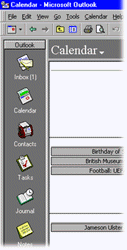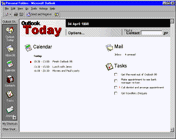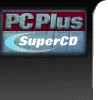| Outlook 98 tutorial See
also Outlook 98 installation
 Outlook 98 is the latest
version of Microsoft's personal information manager. It builds on the successes of its
predecessor and adds quite a range of new features. As well as managing your diary, to-do
list and contacts database, Outlook 98 can take care of your faxing and e-mail related
tasks. If you are a network user you can also use it to share information with other
people, thanks to a new and improved version of Microsoft Exchange. Dedicated users of
other Microsoft products, such as the various components of Office and Internet Explorer 4
will find plenty of opportunity to link between Outlook 98 and those applications. The
overall idea behind Outlook 98 is to provide a familiar interface for every aspect of your
work and to make the dividing lines between different applications as thin as possible. Outlook 98 is the latest
version of Microsoft's personal information manager. It builds on the successes of its
predecessor and adds quite a range of new features. As well as managing your diary, to-do
list and contacts database, Outlook 98 can take care of your faxing and e-mail related
tasks. If you are a network user you can also use it to share information with other
people, thanks to a new and improved version of Microsoft Exchange. Dedicated users of
other Microsoft products, such as the various components of Office and Internet Explorer 4
will find plenty of opportunity to link between Outlook 98 and those applications. The
overall idea behind Outlook 98 is to provide a familiar interface for every aspect of your
work and to make the dividing lines between different applications as thin as possible.
To get the most from Outlook 98 you need to spend a little time mastering its features.
If you are already an Outlook user this will be very straightforward as little has changed
in terms of look and feel or mode of operation. If you are migrating from another personal
information manager, or have no previous experience of PIMs, the early work may be more
demanding. To make it as easy as possible, we've put together a walk-through to introduce
some of the basics.
Installation and setup
The first decision you need to make with Outlook 98 is which of the
three installation options to choose. Minimal only installs Outlook 98 itself and the
latest version of Microsoft Internet Explorer - version 4.01. Standard adds the help files
and a Full installation adds various extra components such as NetMeeting, which is useful
for collaborative working over the Internet, Office Assistants which provide special help,
a range of converters for data stored in popular PIM applications and some potentially
useful system tools. The features we are going to look at below are all installed with the
Standard Installation, recommended if you are new to Outlook.
Outlook 98 can be configured to act as your e-mail client. If you already use an
earlier version of Outlook, Outlook Express, Netscape Messenger or Eudora it will
automatically obtain all the configuration information it needs from that application. It
can also import your e-mails, including their file structure if they are sorted. If
Outlook 98 is going to be your first e-mail client, you'll need to configure it manually.
Click on Accounts in the Tools menu and choose the Mail tab. Click Add and the Internet
Connection Wizard will start up. This will ask for details of your Internet account. If
you have more than one account, you can configure them all, as Outlook 98 is quite happy
handling multiple e-mail accounts with different ISPs.
It is a good idea at this point to configure the user settings too, or at least
familiarise yourself with what can be configured. These settings enable you to customise
many of Outlook's operations. Under the Tools menu click on Options and step through the
tabbed windows, making any changes you need. This may take some time as many of the
windows open additional boxes. It's best to make a note of anything that you don't
configure now so that it can be altered at a later date.
Contacts
 If you already use another personal information manager, Outlook 98 may be
able to import contacts directly from it. Choose Import and Export from the File menu and
select the application your data is currently stored in. If it is not listed, you can
export from your current application as comma separated or tab separated files and import
these. If you already use another personal information manager, Outlook 98 may be
able to import contacts directly from it. Choose Import and Export from the File menu and
select the application your data is currently stored in. If it is not listed, you can
export from your current application as comma separated or tab separated files and import
these.
To add a new field to the already large list of fields available for contacts, choose
Current View from the View menu and choose Customise Current View. Then click Fields and
choose New Field. A small dialog box will ask you to name the field, and designate it as a
particular type and format. The options available in the format dialog will change
depending on the type of field you select. For example, choose a date type and various
date display options will become available. The dialog you saw when clicking Customise
Current View, Fields enables you to change the fields you see at any particular time in
views which are already named. These are listed under the View, Current View menu. To add
an entirely new view of your own making, choose View, Current View, Define Views. The view
you create will itself be listed as an available option.
To-do and diary management
Outlook 98 enables you to see calendar items and tasks as separate
classes of information. Both have their own icons which sit in a shortcuts bar down the
left hand side of the screen. However both are integrated in, and can be edited from, the
Calendar view. Switch to that view by clicking on Calendar in the shortcuts bar.
To create a new to-do item, double click in the area marked Task Pad. A new dialog will
appear, with two tabbed windows, Task and Details. First give your task a Subject. This is
what you will see in the Task Pad so make it meaningful. Then set the priority and any
reminder alarm using the radio buttons. In the large space below you can write text that
helps describe your task. The Details tab lets you record additional information for a
task such as important contacts, or billing information.
If you are setting up a regular task, such as a weekly meeting you can define it as
such by clicking on the Recurrence box. This enables you to configure various recurrence
patterns, such as the first Tuesday of every month, or every Thursday or even once on a
particular date every year. You can even set an end date for the recurrence.
The other part of the calendar view shows your diary. Initially it will be entirely
greyed out with no appointments set. To configure an appointment, double click on the
Calendar view at the place you want the appointment to begin. Complete as much of the form
as you need to and click Save and Close. Your task will now appear on the calendar. You
can move the whole event to a new part of the day by clicking in the blue bar at its left
and dragging it, or change the period of time the event covers by dragging the upper or
lower bar.
Experiment with the Work Week, Week and Month views on the toolbar to find out which
view you would prefer to see.
E-mail and faxing
 The Internet is integrated to all aspects of Outlook 98 and it can be
accessed from almost every part of the application. For example, when in Contacts view you
can elect to send an e-mail to a contact by clicking on a toolbar icon or choosing New
Message to Contact from the Actions Menu. The Internet is integrated to all aspects of Outlook 98 and it can be
accessed from almost every part of the application. For example, when in Contacts view you
can elect to send an e-mail to a contact by clicking on a toolbar icon or choosing New
Message to Contact from the Actions Menu.
Outlook 98 has its own area for managing e-mail - the Inbox. Clicking on this will show
all incoming and outgoing e-mails. A double click on any e-mail on the In list will enable
you to read it.
E-mail filtering is important for anyone who receives a steady flow of messages.
Outlook 98 includes a special Rules Wizard that enables you to set up your own system for
filing, deleting, forwarding and marking for special attention any incoming and outgoing
e-mail. It even claims to be able to detect spam (junk e-mail).
To use the Rules Wizard, go to the Inbox view and then choose Rules Wizard under Tools.
Click New, and decide what kind of rule you want to set up from the list. Work through the
Wizard, choosing options that are meaningful to your needs and adding text that applies to
the rule as it is needed.
It is also possible to fax directly from Outlook 98 using the fax component of
Microsoft Exchange. If this is not installed, add it using Windows setup in Control
Panel's Add/Remove Programs. Once it is installed, click the File menu, point to New, and
then click New Fax Message. Word opens as your fax editor. You can attach pre-written
documents to a fax, and use a header. When you are ready to send the fax, click on Send
and a Wizard will guide you through the rest of the process.
Other useful features
 There are many additional extra features that Outlook 98 offers which help
enhance its appeal. There are three in particular which new users might find especially
helpful - the Journal, AutoCreate and Outlook Today. There are many additional extra features that Outlook 98 offers which help
enhance its appeal. There are three in particular which new users might find especially
helpful - the Journal, AutoCreate and Outlook Today.
The Journal maintains a list of actions in Outlook 98 and documents created in any
Office application, which it arranges visually on a timeline. Clicking on any of the items
shown in the Journal takes you straight to their entry if they were created in Outlook 98,
or opens them in their application if they were created using Office. In effect, then, the
Journal acts rather like a shortcut to recent work - as long as you are using Microsoft
applications, of course. To configure the Journal choose Options in the Tools menu and
then Journal Options. Once configured choose Journal in the shortcuts bar to see its
output.
AutoCreate has been designed to take advantage of the fact that in modern working
environments many new contacts, tasks and meetings are initiated by e-mail. The feature
enables you to drag an e-mail from the Inbox onto the Contact, Calendar, Tasks button on
the shortcuts bar and rely on Outlook 98 itself to create as much as possible of a new
entry. You can edit the remainder of the entry by hand.
Finally, Outlook Today acts as a central reference area for your calendar items and
tasks and shows any unread e-mails. The contents of the Outlook Today window are created
automatically from entries in other parts of Outlook 98. It is generated using Dynamic
HTML, which means that many of its elements are active. Clicking on a task, for example,
takes you to its complete entry while clicking on the Tasks icon takes you to the broader
tasks view.
Conclusion
Outlook 98 is not an application whose complexities you will master
in an hour or so, but you will be able to get up and running with it in that time. There
is an awful lot to this application and how much you delve into its depths depends in
large part on your needs. We have given you enough information here to get started and
work with Outlook 98 effectively, but there is a lot more to explore. We have not touched,
for example, on any of the group functions which will appeal greatly to networked users.
See also Outlook 98 installation |



